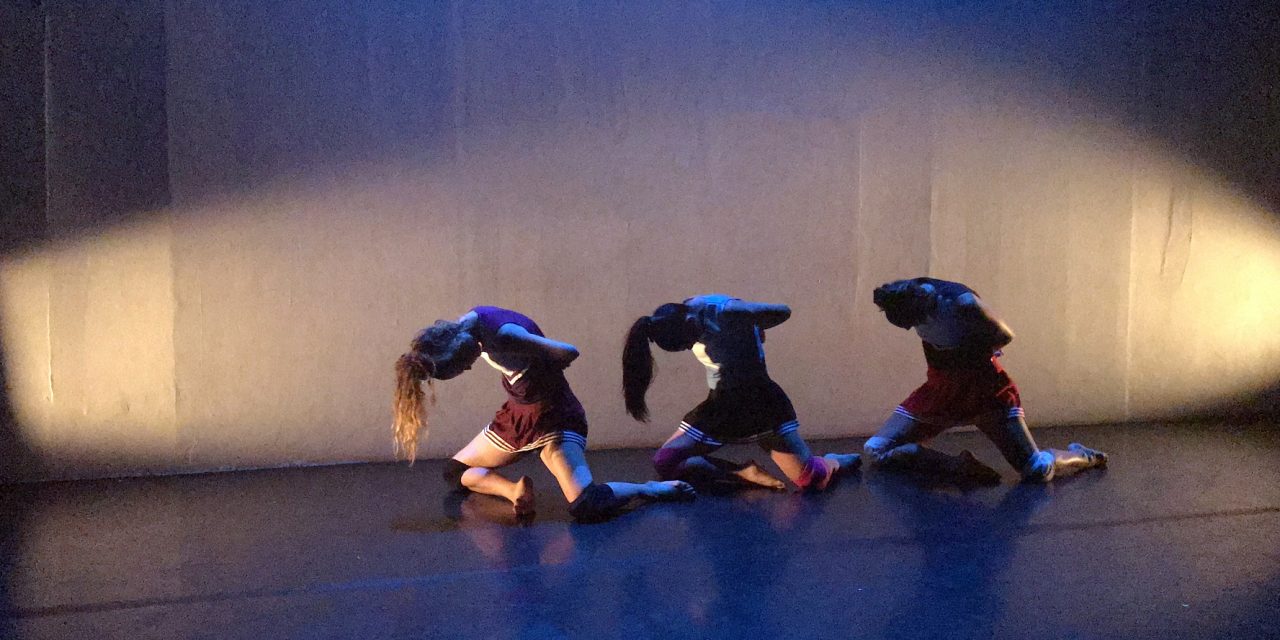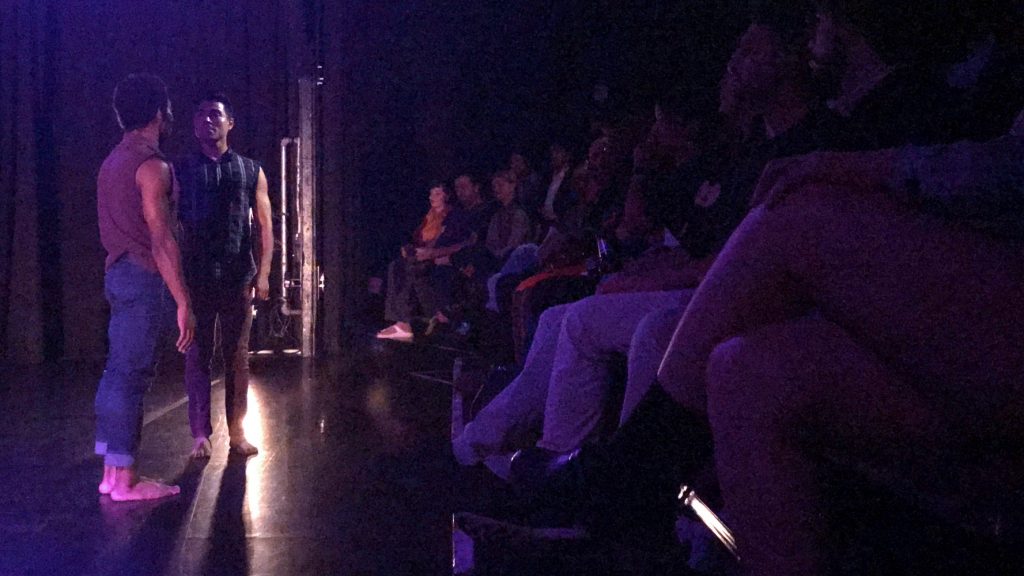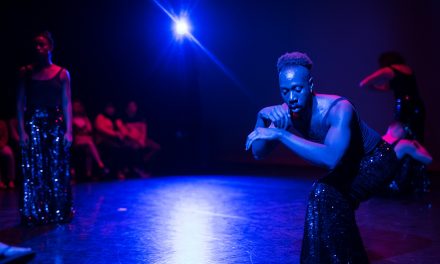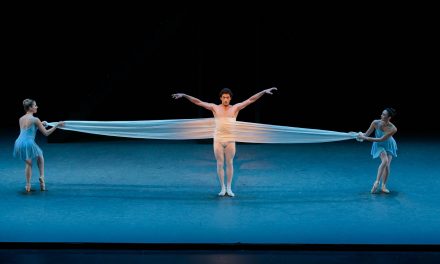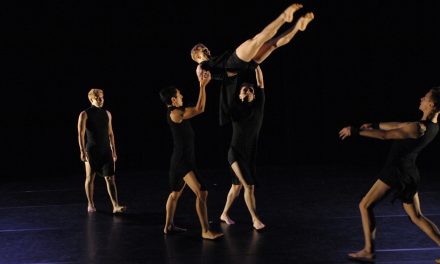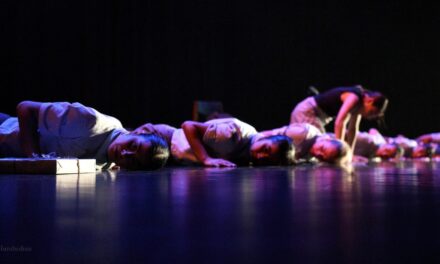Friday, October 12’s presentation of OVERNITE, a two-piece gem at Highways Performance Space, showcased a creative approach to the question of dancing vs. music that took on a chicken and egg assessment to the question of attitude and energy: does the music dictate our moves? Or does the evolution in our movement affect the music we listen to today?
The evening began with a duet of sorts to what choreographer and artistic director, Barry Brannum, labels as having a work that “was born sometime in the days after disco”. Blood Blood Blood looks at the waxing and waning relationship between his character and that of fellow dancer Harvey Peralta as they dance to samples from Larry Levan’s mix of “Stand on the Word” by the Joubert Singers, Dub & Club mixes of “Can’t Get Enough” by Liz Torres with Master C&J, and “Love Can’t Turn Around” by Farley “Jackmaster” Funk and Darryl Pandy. The title seemed to be a reflection of how much tenacity each dancer placed in their role. Brannum’s vague pre-show description kept viewers guessing as to what they might expect to see that Friday night. There was a pleasantly surprising amount of humor within the piece that veiled the work in light caricature as the performers mocked machismo and the self-indulgence involved with “feeling yourself” on the dance floor.
The piece began as audience members were still piling into Highways’ small theater, with Brannum and Peralta moving on the floor in slow motion to steady beats like dripping water. Their faces remained expressionless as the house lights dimmed and a red spotlight took over the stage. Their initial subtle movements quickly picked up momentum as they lifted their bodies off the floor in segments, eventually facing each other before kicking up their legs and embracing the disco-sounding music. They bent their heads into the crook of one another’s neck and shoulders, bonding sensually as they hugged before collapsing onto the ground and rubbing their upper bodies against each other in tune with the melody. Their rhythm resembled moves often seen in an ’80s jazzercise workout video. Their pulsing became a more recognizable pattern of dance that took on an elegant, balletic form interspersed with post-modern poses.
Brannum and Peralta remained mostly in sync throughout the piece, painfully aware of each other’s presence the entire time, even when it seemed as though they were off in their own worlds. There was an air of competition between them as they performed different versions of the same movements, whether they were standing upright or crawling on the floor. The highs and lows reflected their shifting moods as they continuously reevaluated their relationship. A significant scene that took place about midway through their performance was a confrontation wherein they stood upright, looked each other in the eye, as if sizing one another up, and appeared ready to launch into a cock fight, teetering back and forth like seesaws before finally tilting their bodies away. The intimidating moment was funny and caused most of the audience to erupt into quiet fits of giggles, lightening Blood Blood Blood’s mood.
As the show went on, the music advanced through the decades, as did their contemporary choreography, which they mixed in with club dancing that evolved during and after disco’s heyday. ’90s-era R&B and early 2000s house music took prevalence later in the piece. LA’s first rain of the season complimented the beats present throughout the evening. The quick pulsing resulted in their rushing one another and engaging in more physical contact as Peralta leapt on Brannum’s back, the latter carrying him as though they were halfway through a game of leap frog. Though the dance began with plenty of physicality, the switch in styles reflected the changing of the era. Although there were definitely times when it seemed like the music was leading the movement, the seamless transitions also made it appear as though it were happening the other way around.
A blackout and quick venture behind the side curtains resulted in their dramatic re-emergence upstage center to a fully-realized party atmosphere with comic dazzling spirit fingers indicating the two may have found themselves at a gay club. Brannum’s soundscape blended the music together until it was difficult to tell exactly which time period they were in and their don’t-stop-till-you-drop attitudes collided in fisticuffs that carried through the final fade-out, each dancer fighting for dominance right until the very end.
After a brief stint of roaring applause, it was time for Casey Brown’s trio of cheerleaders (Brown, Chantal Cherry and Clarissa Mejia) to take over the prissy mood set by the conclusion to Brannum’s piece with a little chanting and showing off of their own. UP.BEAT.DOWN’s interpretation of the dance/music relationship came in the form of repetition and plenty of positional shifting, which allowed the routine to be seen from different angles. Also performed to rhythmic house music, the pieces blended into each other very well, each conveying a similar story from completely different points of view.
Brown’s squad was dressed for the part, and had their faces painted to promote that distinctive brand of school spirit present in unity. The majority of the dance saw the women moving identically and at the same time. Their characters panicked when they noticed any degree of separation, unlike in Brannum’s piece wherein the dancers seemed to draw strength from their brief time apart. Like Blood Blood Blood, however, synchronicity was the driving force that carried UP.BEAT.DOWN forward.
The number was structured like a basic cheer routine, but with a post-modern twist. It began with all three women posing against the newly bare wall at the stage’s rear. They rotated slowly to one side before sliding down the wall. They suddenly straddled it as they pulled themselves back up to a standing position as though stretching before their big performance. The beginning of their dance was more of a creative mishmash. Strong foot stomps were paired with karate chopping arms and sharp upward kicks slicing through the air.
“Get ready!” and “1,2,3,4” counts further always emphasized the cheer-like aspect and their desire to stay in tune with one another. The chants rang out as the dancers repeatedly switched formations into a straight line, then back into a triangle. As the dance progressed, the techno music, which consisted of Lumisokea, Pan Sonic, Tsuzing, Paula Temple, and SHDW & Obscure Shape, played faster. All three moved quickly to catch up with the flow, high jumping in place and into new positions as they pulled their legs up under them each time, exhaustion taking over their faces as they stared straight into the crowd like creepy dolls with shiny eyes and pretty hair bows. At one point, a light tune resembling Hitchcock’s Psycho theme played overhead and completed the image.
The dancing got more erratic and sloppier as time went on, eventually incorporating a non-concurrent upward jump clap. Once again, it seemed purposely difficult to tell whether the music was sped up to match the exuberance of the movement, or the trio was driven to move faster thanks to the melody’s manic speed. Their most distinctive cheer was the well-known “Be Aggressive” with aggressive being spelled out several times as a way to drive home their intensity. Toward the end, they resembled cartoons, hustling together to do a straight-faced cancan, which caused the whole theater to laugh. Holding on to one another, their final jumping hugs and chest bumps to their self-encouraging shouts of “You can do it!” pushed them to the edge. They each froze solid, stopping one at a time to look at each other in bewilderment, a puzzling “Should we keep going?” look on their faces before they simultaneously looked up at the light and ended the routine.
A fun dance party followed the end of the show, with ’70s and ’80s music blaring overhead and successfully encouraging viewers to rush the stage, the performers’ enthusiasm having rubbed off on the audience.
Both pieces were dramadies that asked big questions about the evolution of music and dance and its involvement with humanity’s need to socially jibe, but without either show taking itself too seriously. It was an interesting examination of a trend that most definitely did not develop OVERNITE.
For more information about Highways Performance Space, click here.
Featured image: Barry Brannum and Harvey Peralta in Brannum’s “Blood Blood Blood” – Screen shot by Patrick Kennelly

